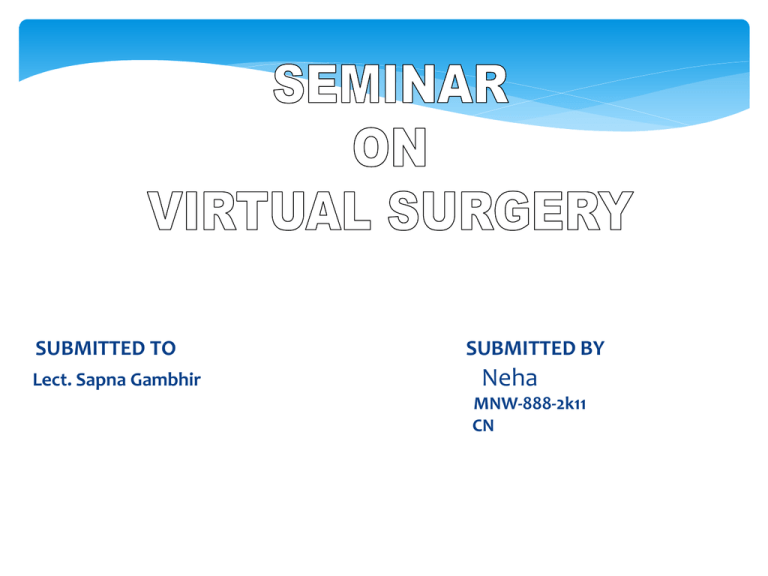Introduction of Virtual Surgery
advertisement

SUBMITTED TO Lect. Sapna Gambhir SUBMITTED BY Neha MNW-888-2k11 CN INTRODUCTION Advancement in computing power have enable continued growth in virtual reality, visualization and simulation technology Virtual reality is defined as human computer interface that simulate realistic environments while enabling participant interaction, as a 3D digital world that accurately models actual environment. Need for Virtual Surgery In surgery, the life of the patient is of utmost importance. Many patient have lost lives because of surgical errors. VR provide good tool to experiment the various complications arise during surgery Introduction of Virtual Surgery It refers to a virtual reality simulation Actual patient is not required Doctors can practice on a virtual patient before performing the surgery What is Virtual Surgery Virtual Surgery, in general is a Virtual reality technique of simulating surgery, which helps surgeons improve surgery plans and practice surgery process on 3D models. The virtual surgery is based on the patient specific model, so when real surgery takes place, the surgeon is already familiar with all the specific operations that are to be employed HISTORY The first virtual surgery was performed in 17 Aug 2009 when Dr. David clarke in Halifax,Nova Scotia removed a brain tumour 24 hours after removing a simulated tissue. Project Odysseus was developed to form a 3D image of a person’s liver to allow surgeons to train before a surgery. France Telecom also develop a communication system for the project callde argonaute Virtual Reality Technique It is a virtual reality technique of simulating surgery procedure It helps surgeons in improving surgery plans They practice surgery process on 3D models Virtual surgical tools or gloves are connected to motion sensors where the users can physically feel the difference in simulated tissue and organs. Virtual Reality Application Training & education Surgical planning Image Guidance Tele surgery Training & Education Traditionally textbooks images or cadavers were used Today VR simulators are becoming the training method It allows the users to view the anatomy from wide range of angles Surgical Planninig Traditionally surgeon calculates various parameter & procedures This leads to lot of errors Virtual reality helps in reducing errors Plans surgery in reliable manner IMAGE GUIDANCE The integration of advanced imaging technology, image processing and 3D graphical capabilities has led to great interest in image guidance and computeraided surgery. It also provide useful in Robotic Surgery, a new technique in which surgeon remotely manipulate robotic tool inside the patient body Tele Surgery Allows surgeon to operate on people People are physically seperated from themselves Done through master-slave robot Virtual Reality Simulation 3D image simulation Touch simulation 3D Image Simulation Generate a 3D model Depending upon this simulation needed, anatomical images can be derived from series of patient’s MRI or video recording, which are 2D images. Images are segmented and constraints are imposed. Cont… Then we construct a reference model. After that obtain final model by deforming the reference model. Touch Simulation Simulating haptic touch sensation. Calculation of force applied to cut & punchers the various tissue. Haptic goes a long way to make virtual reality simulators more life like Virtual Reality Simulators Consist of powerful PC Run the software To interact with virtual environment The addition of haptics to virtual environments has provided computer users with the ability of expression in multiple dimension. Importance of VR Minimizes the no of medical mistakes Effective use minimal access surgical technique Better training in anatomy and surgical skill which reduces the need for cadavers. Disadvantages Short coming in realism of simulation Costly Need human computer interfaces Conflicts between sensory information





